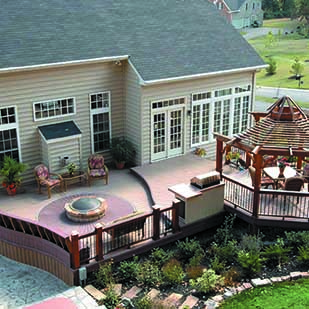Mar. 12, 2019
The wood plastic factory often received complaints from customers, and water stains on the surface of PE-based plastic wood boards were different. The reasons were unknown. The most reaction is wallboard, fence board and the like. This type of material is different from the deck floor. The floor is stepped on every day. The surface often has object friction, and it is not easy to accumulate unidentified materials. The surface of the profile such as wall board and fence board does not contact with other objects, the blot is naturally produced. Customers ask for reasons to avoid future occurrences, and many plastic wood manufacturers cannot give reasonable explanations and solutions.
For the above-mentioned problems, today, we will talk about some of the reasons for the occurrence of water stains, and discuss them with industry technicians. I hope to inspire and help solve this problem.
There are many reasons why water stains or other blots may occur. The first step is to analyze whether it is water stains or other blots. In addition to water stains, other possible blots are:
1. Whether the use environment of the board has other sources of pollution, such as the kitchen fumes, which will adhere to the surface for a long time;
2. Corrosion of the surface of the material by acid rain;
3. Localized mildew on the surface of the material;
4. Adjust some colors and added carbon black, poor quality carbon black fading, but uneven or plasticized, poor dispersion, resulting in uneven color change of the material;
5. Unidentified substances scattered in the air adhere to the surface of the material;
6. The plasticity of the formula is too poor, the addition ratio is not enough or the plasticization is not well dispersed, and the material is locally aged and weathered;
7. The wander produced by the serious precipitation of the oligomer, the oil stains then adsorb the dust.
If the above reasons are excluded and the water stain is confirmed, let us first look at the mechanism of water stain formation. The water droplets are deposited on the surface of the object for a long time, and the water droplets will absorb the dust in the air. After the water droplets are evaporated, the minerals and adsorbed dust in the water will remain in the original position of the water droplets, forming water spots from the surface. Over time, more and more minerals and dust are deposited, and water stains will become more and more obvious.
If there is a certain oily substance on the surface of the material, the water is not evenly spread on the surface of the material under the surface tension of the surface of the material. The horizontally placed surface forms a beaded, vertically placed surface under gravity and surface tension. Under the action of the dripping or irregular shape, it is as follows on the surface of the lotus leaf after rain and on the windshield of the car. After the dust is absorbed, the water evaporates, and the minerals in the dust and moisture form water spots in the original position of the water. With these water stains adsorbed on the surface, the surface tension of these places will decrease after the next time you touch the water, and the water will be more likely to accumulate in these places, forming a vicious circle. Over time, natural water spots will appear. At first, the water stains were white. After a long time, the white particles piled up and became black.
The mechanism of generation is clear, then what we have to do is to minimize the generation of oily substances on the surface of the material. In general, the small molecular substances on the surface of PE plastic wood board are mainly as follows:
1. The oligomers and waxes produced by the decomposition of materials during the process will migrate to the surface of the material during the extrusion process, just as the water will flow out when the towel is wet;
2. Small molecular substances in lubricants, such as PE wax, oxidized polyethylene wax or other small molecules of lipids;
3. Other auxiliary carriers in the form of masterbatch;
In order to minimize the precipitation of oily small molecules on the surface, it can be improved from the following aspects:
1. Consult the lubricant supplier whether the compound lubricant contains a large amount of easily precipitated small molecules.
2. Improve the production formula, some wall panels, fencing panels can use a certain amount of LDPE, improve the fluidity of the material, make the raw material formulation system easier to process, thereby reducing the amount of lubricant added, try to reduce the amount of lubricant added to 1.2% or less.
3. For specific conditions such as different profile structure and thickness of the plate, the lubricant supplier is required to adjust the internal and external lubrication ratio, thereby reducing the amount of lubricant added.
If the amount of lubricant added is more than 1.8%, or a large amount of PE wax or the like in the lubricant, a large amount of small molecules will be precipitated, one is the precipitation of the lubricant itself, and the other is excessive lubricant added. It will accelerate the precipitation of oligomers generated by plastic decomposition, and some oligomers will be oily and viscous, which will cause serious stains and water stains.
